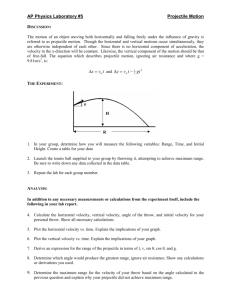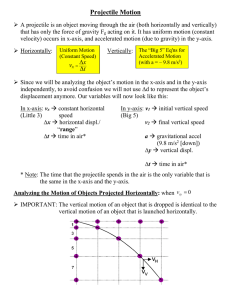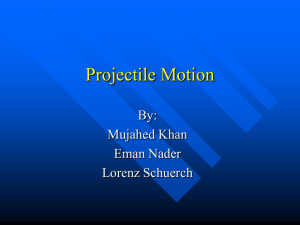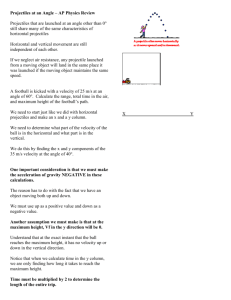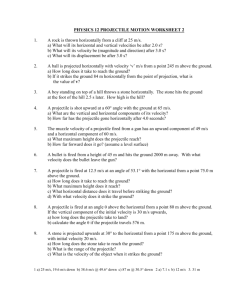Horizontal
advertisement
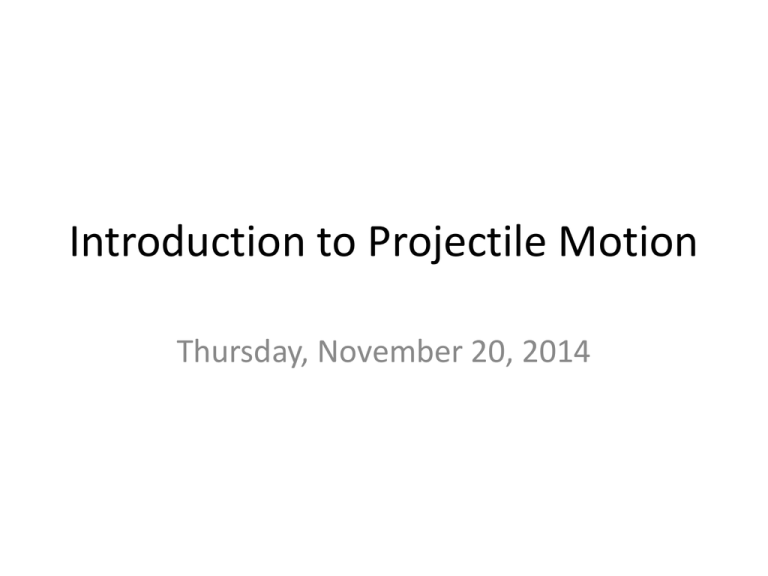
Introduction to Projectile Motion Thursday, November 20, 2014 Thursday, 11/20 Unit 5: Projectile Motion • Pick up a handout from the ‘Physics bin’ • Make note of upcoming dates below. • Respond to the following in the ‘warm-up’ section of your handout. What roles do inertia and gravity have in an objects motion? Do they complement each other or are they at odds with each other? • Upcoming dates – – – – – – – – – – Monday, 11/24 thru Friday, 11/28 Thanksgiving holiday Thursday, 12/4 – exemption window opens Friday, 12/5 – Projectile motion quiz Friday, 12/5 – Review due when the late bell rings Tuesday, 12/9 – Projectile motion test Wednesday, 12/10 – exemption window closes Friday, 12/12 – 3SW extra credit due Wednesday, 12/17 – 2nd period final: 8:35 am to 10:07 pm Friday, 12/19 - 4th period final: 10:00 to 11:20 am Friday, 12/19 – end of the semester Real – life projectiles Where we’ve been • Studied linear motion • Motion in one direction • Included motion in the x direction (horizontal motion)and y direction (free fall) Where we’re going • Combine our understandings of linear motion and vectors to describe and analyze a special kind of two dimensional motion • We will use diagrams, numbers, equations, and words for describing and analyzing projectile motion. Definitions • Projectile – An object that is launched by a force and continues to move by its own inertia – it is only under the influence of gravity • Trajectory – the path of a projectile. • Parabola – geometric shape of the path of a projectile. • Range – the total horizontal distance traveled by a projectile Projectile motion problems are solved by treating horizontal and vertical motion separately. *IMPORTANT* Gravity only affects vertical motion. . 1. object launched horizontally 2. object launched at an angle Objects Launched Horizontally vi = initial horizontal velocity dy = vertical distance t = total time in the air (height) dx = horizontal distance IMPORTANT FACTS There is no horizontal acceleration. There is no initial vertical velocity. The horizontal velocity is constant. Time is the same for both vertical and horizontal. Equation Δd = vi . t + ½ . a . t2 horizontal dx = vi.t vertical dy = 1/2 . ag.t2 Object Launched at an Angle vi = initial velocity q = launch angle q t = total time in air IMPORTANT FACTS dx = horizontal range • The horizontal velocity is constant. • Gravity only effects the vertical motion. • It rises and falls in equal time intervals. • It reaches maximum height in half the total time. • When at maximum height, vertical velocity is zero. • Final vertical velocity is equal to Negative initial vertical velocity • Change in vertical position is zero (because it lands at the same height it was launched from) Structure for Problem Solving • GUESS has not gone away it just looks a little different. G: U: Horizontal (x) Vertical (y) Δx Δy Vi Vi a a t t Structure for Problem Solving (Cont.) E: S: Substitute Variables S: Solve Horizontal Projectile Knowns Horizontal (x) Vertical (y) Δx (given or you will solve for it) Δy (given or you will solve for it) Vi (given or you will solve for it) Vi = 0 A (constant velocity therefore 0) a = 9.8 m/s2 t (given or you will solve for it) t (given or you will solve for it) Note: time will be the same for the horizontal and vertical. Why? Example 1 A stone is thrown horizontally at 7.5 m/s from a cliff that is 68.4 m high. How far from the base of the cliff does the stone land? G: U: E: Horizontal (x) Vertical (y) Δx Δy Vi Vi a a t t Example 2 A baseball is thrown horizontally with a velocity of 44 m/s. It travels a horizontal distance of 18 m to the plate before it is caught. a. b. How long does the ball stay in the air? How far does the ball drop during its flight? G: U: E: Horizontal (x) Vertical (y) Δx Δy Vi Vi a a t t Practice


